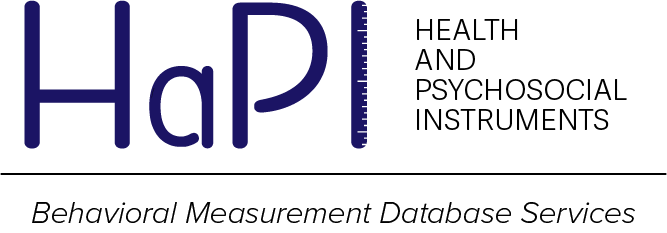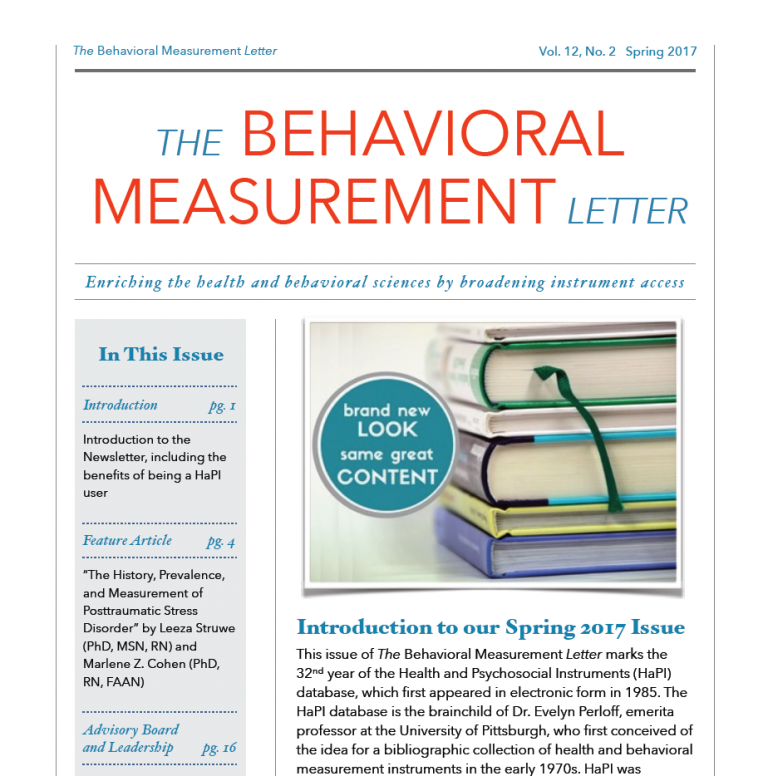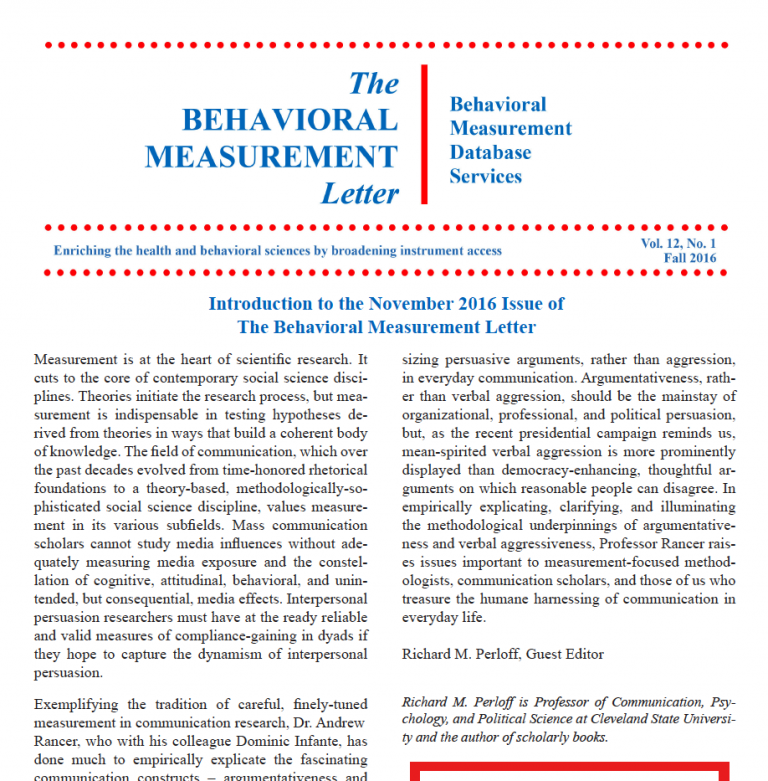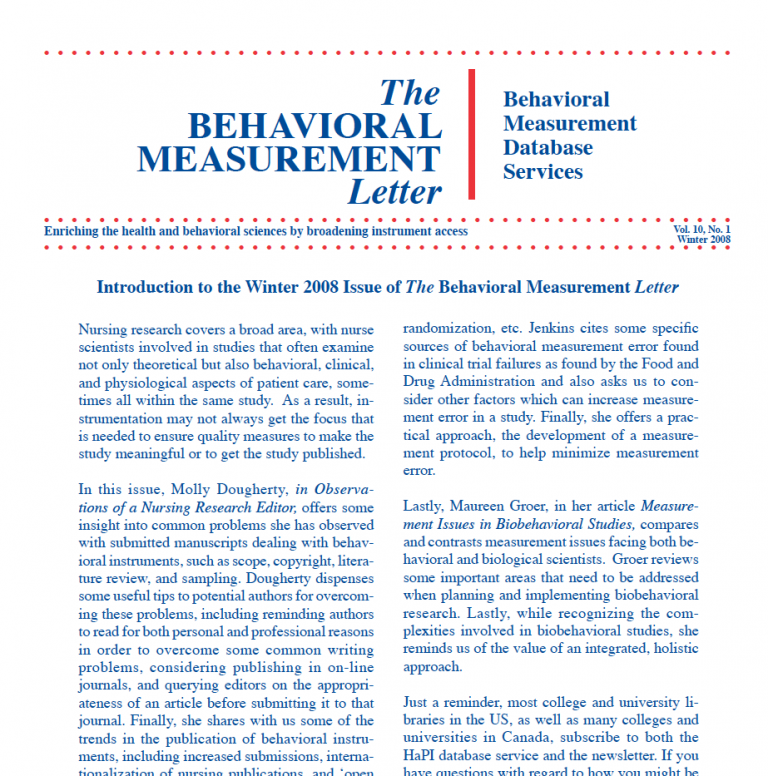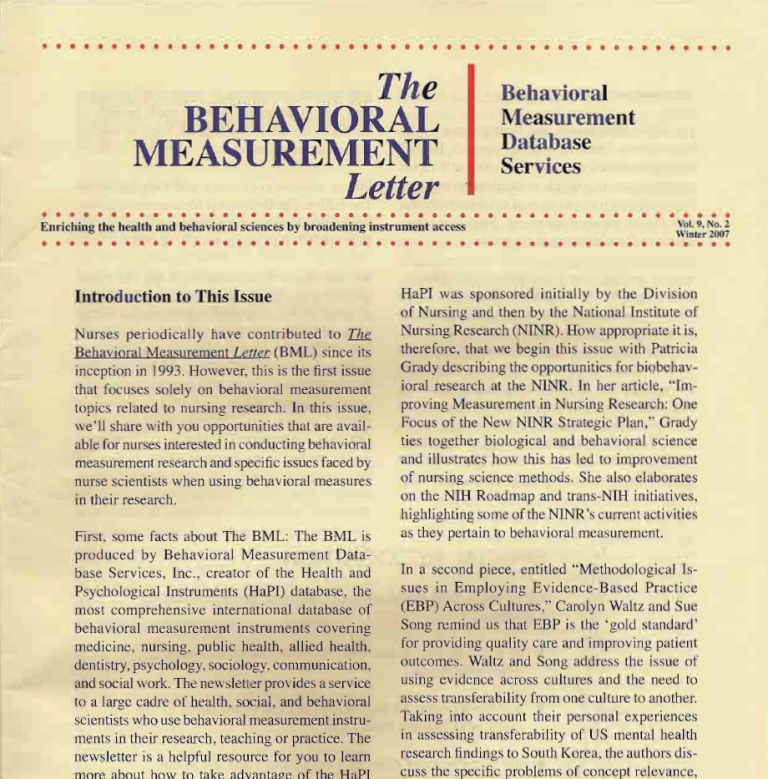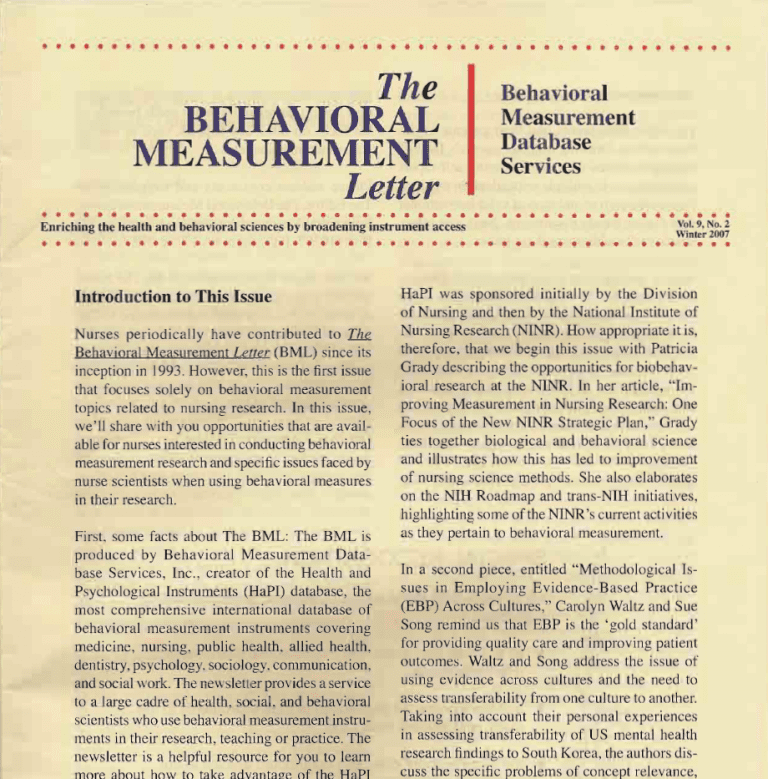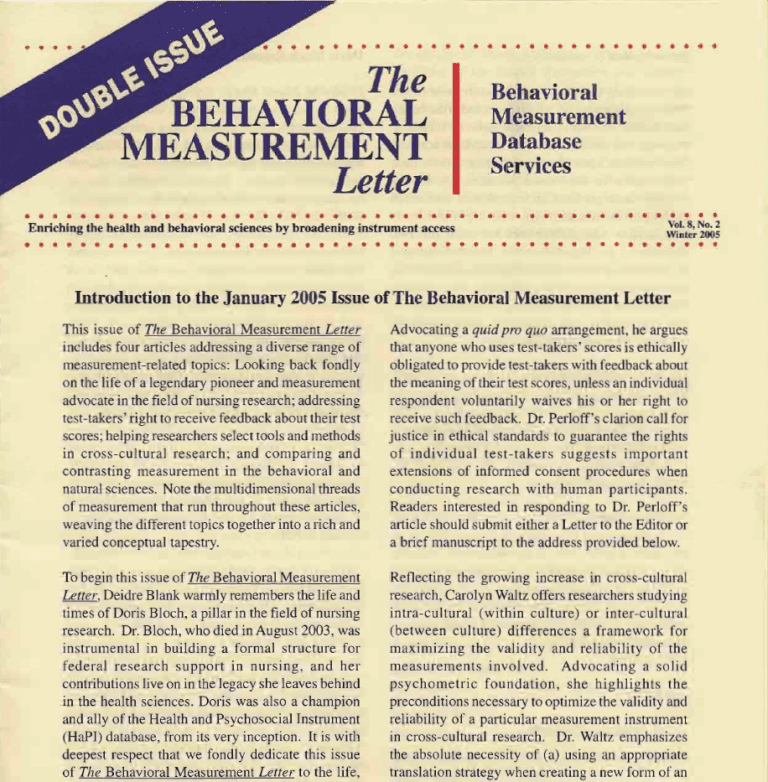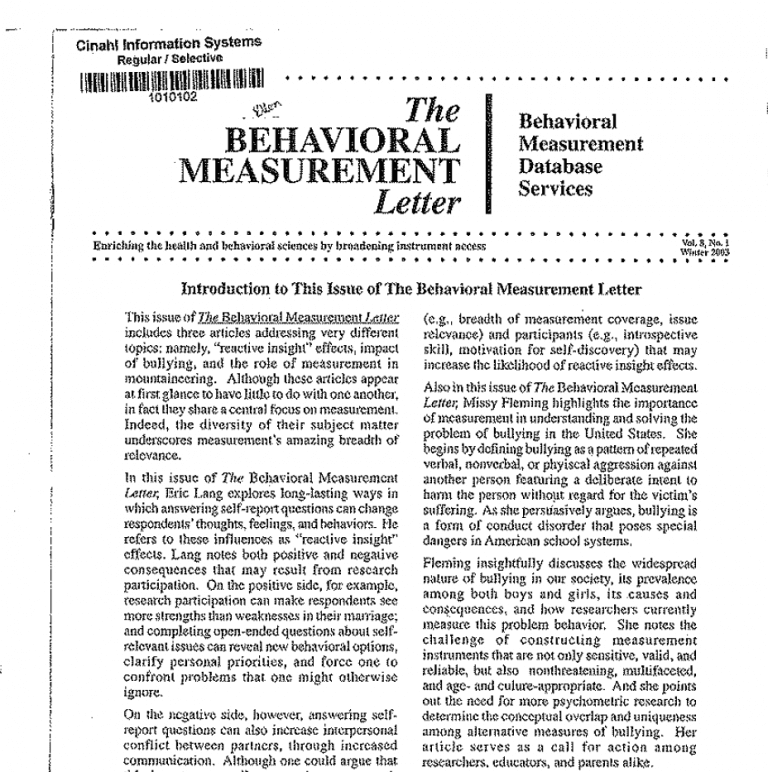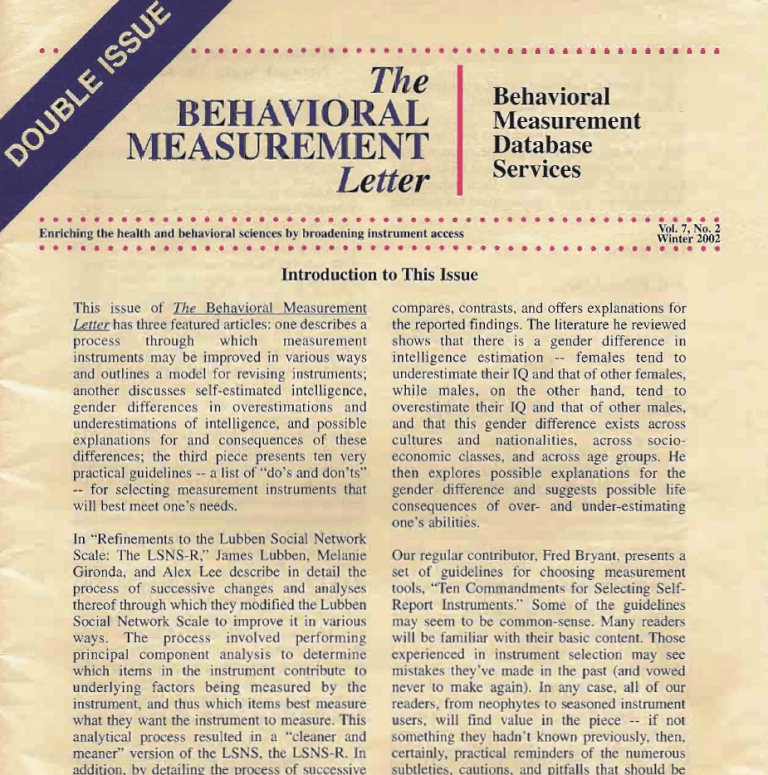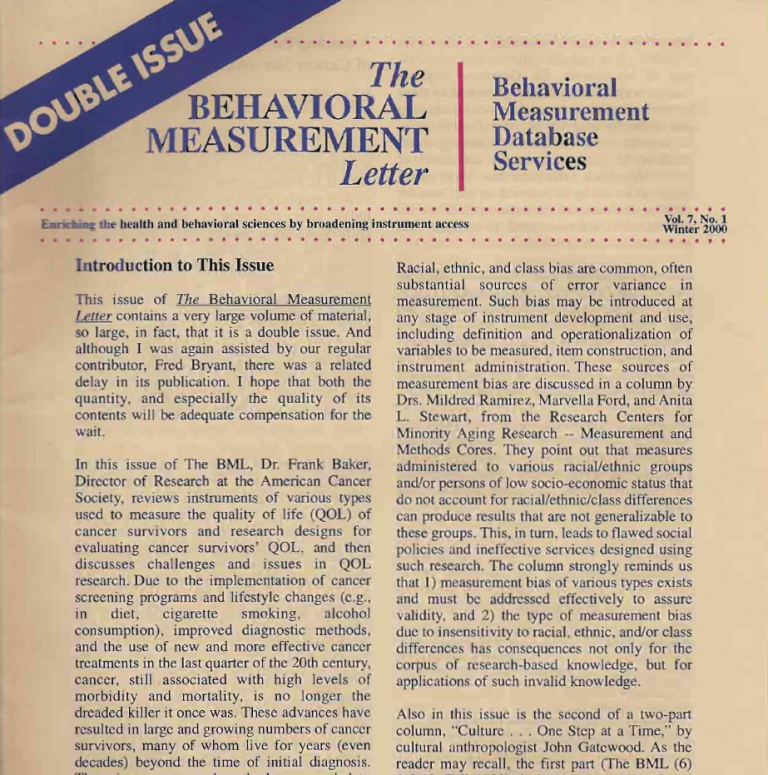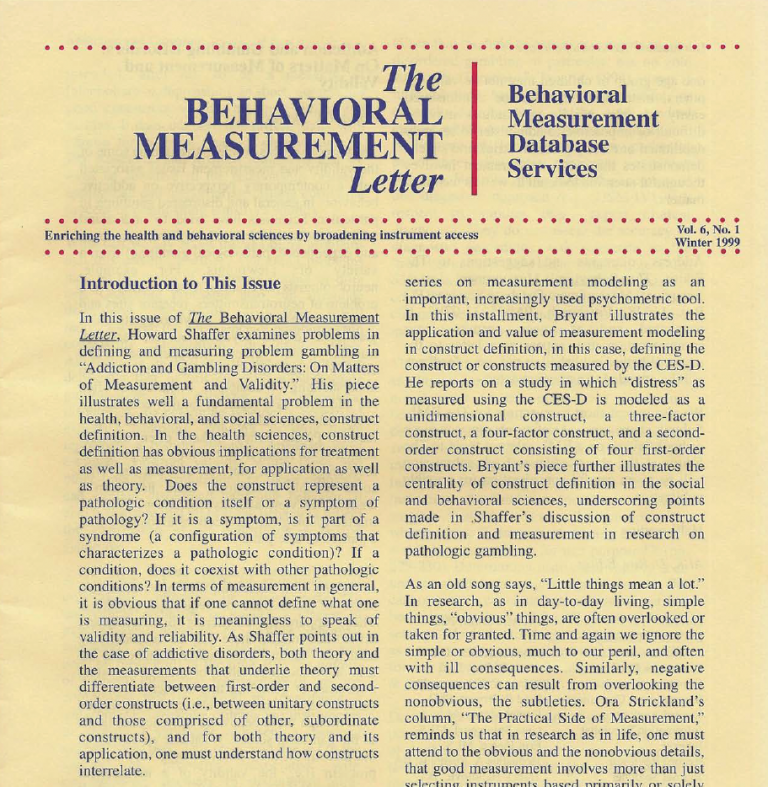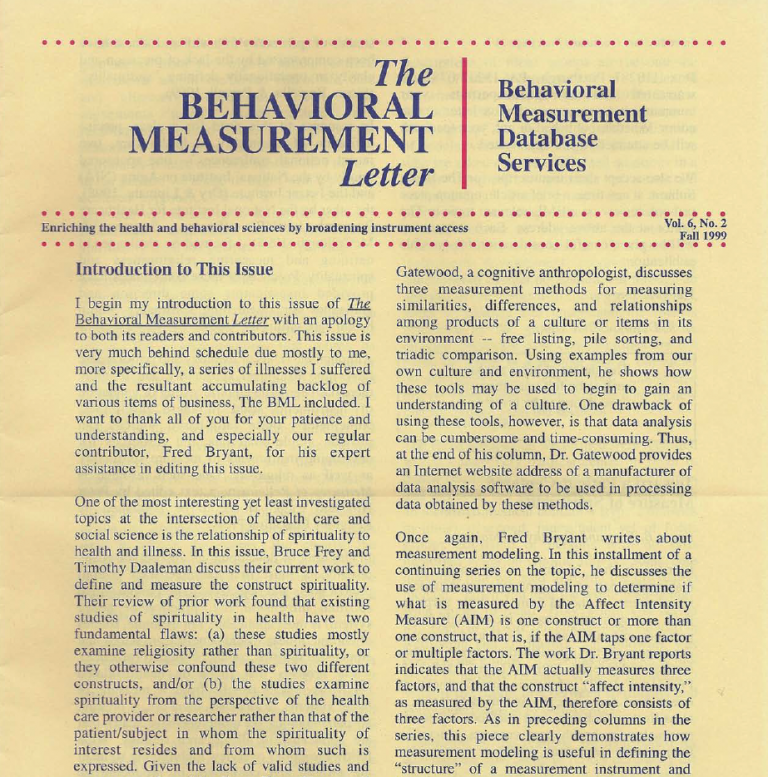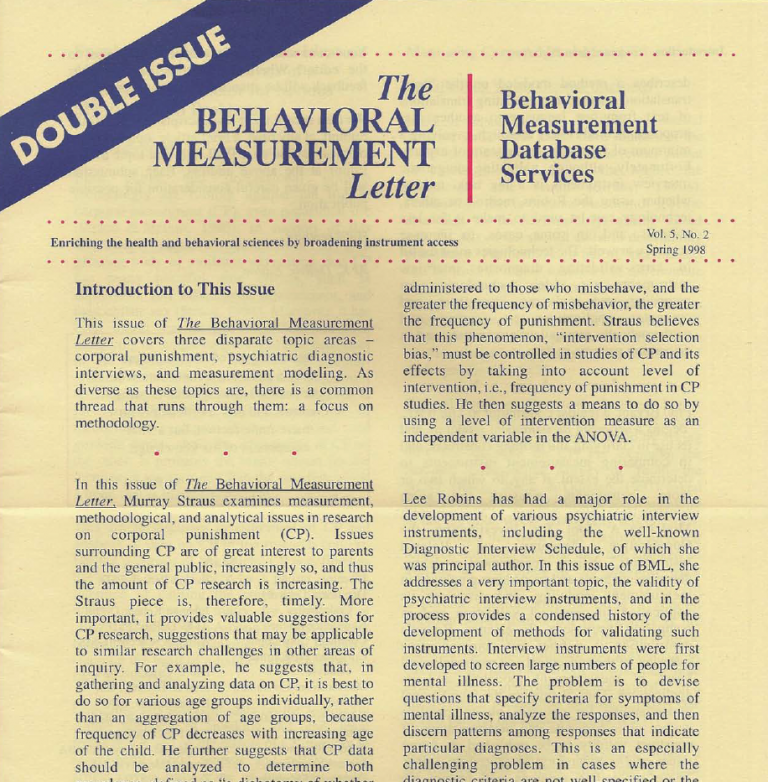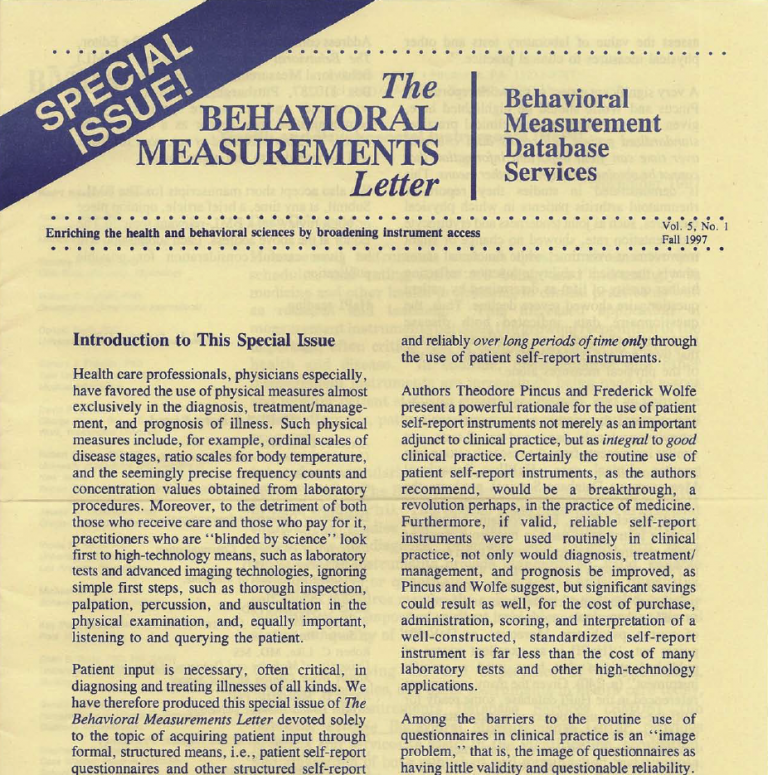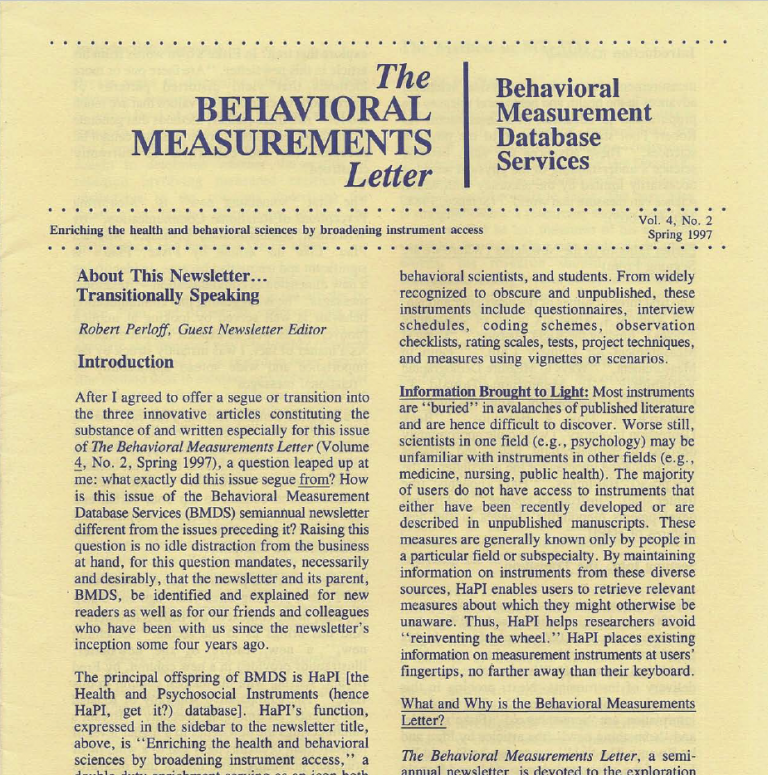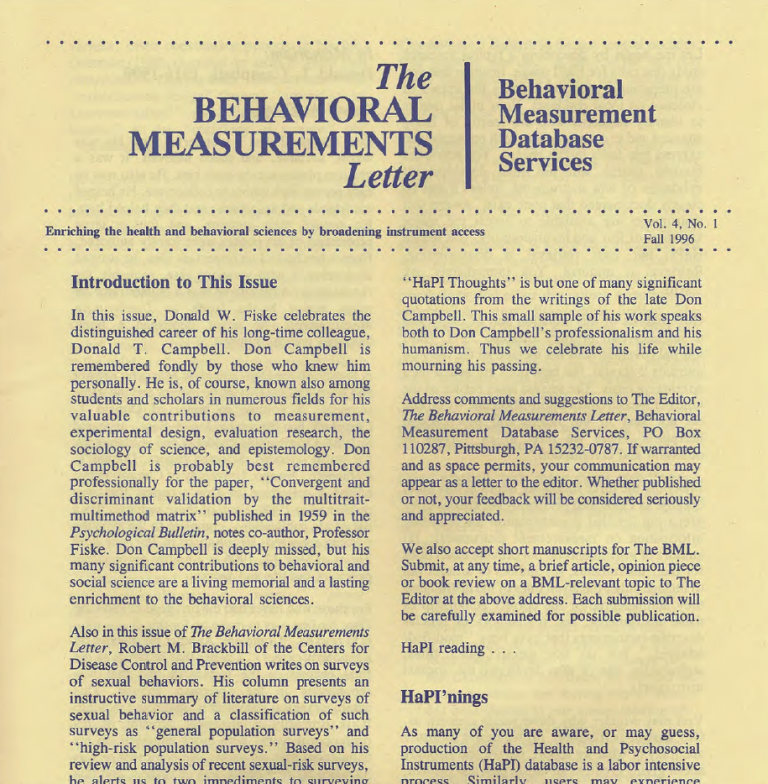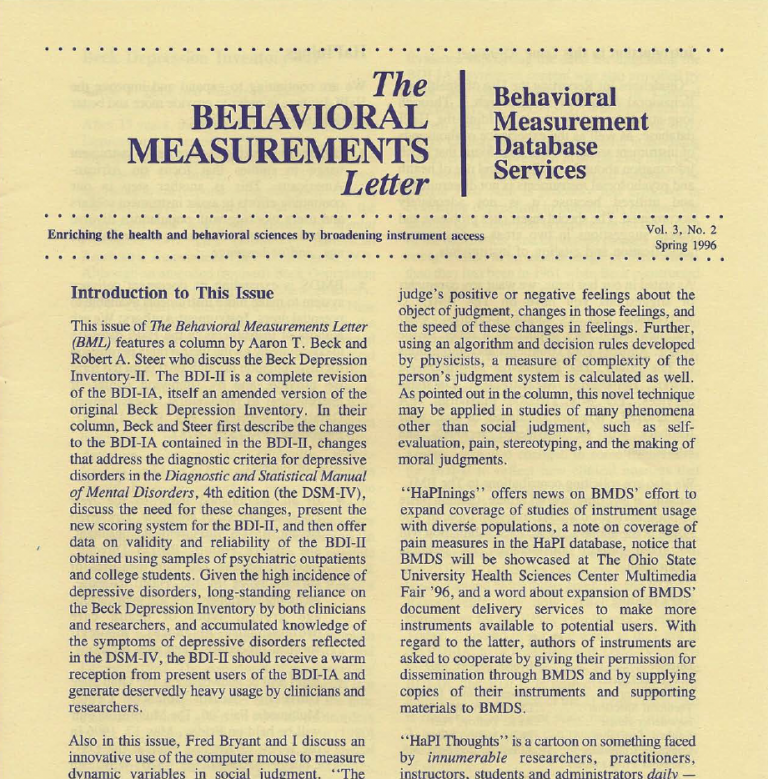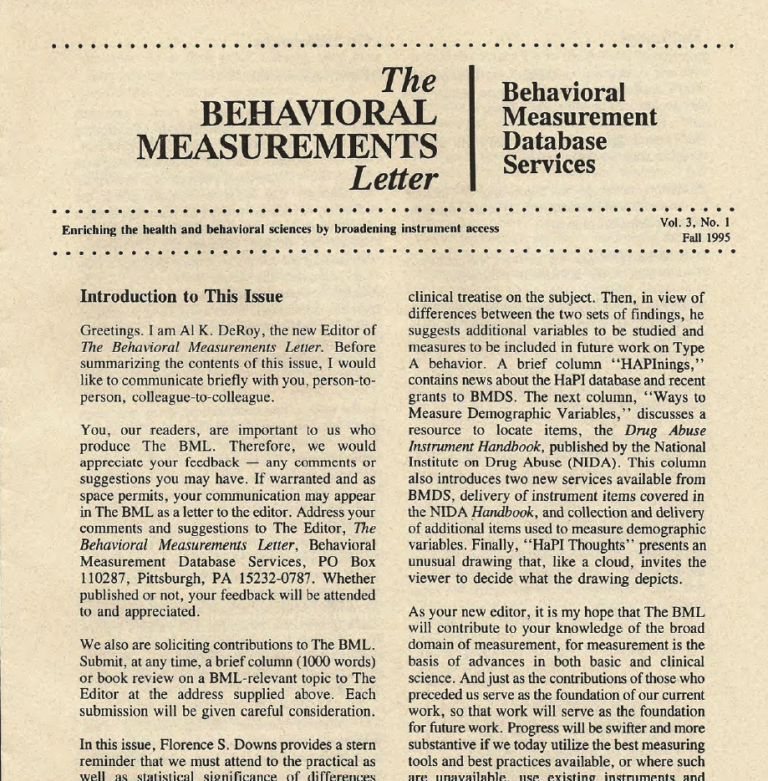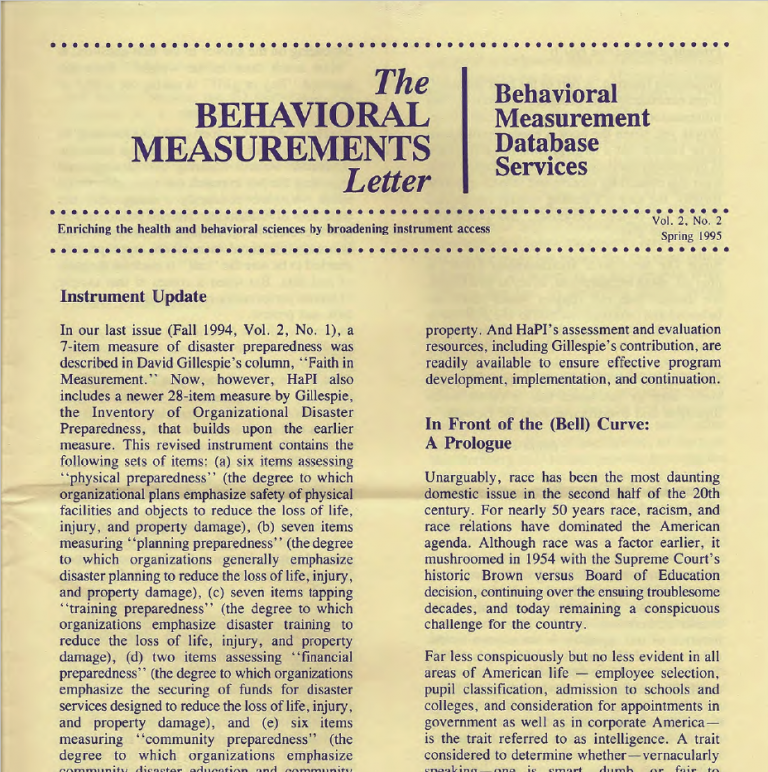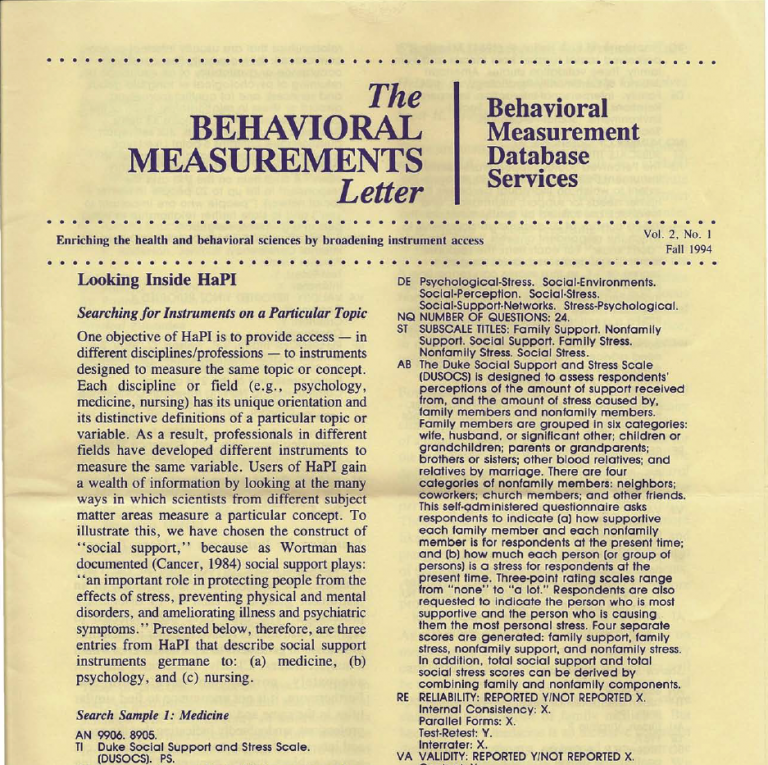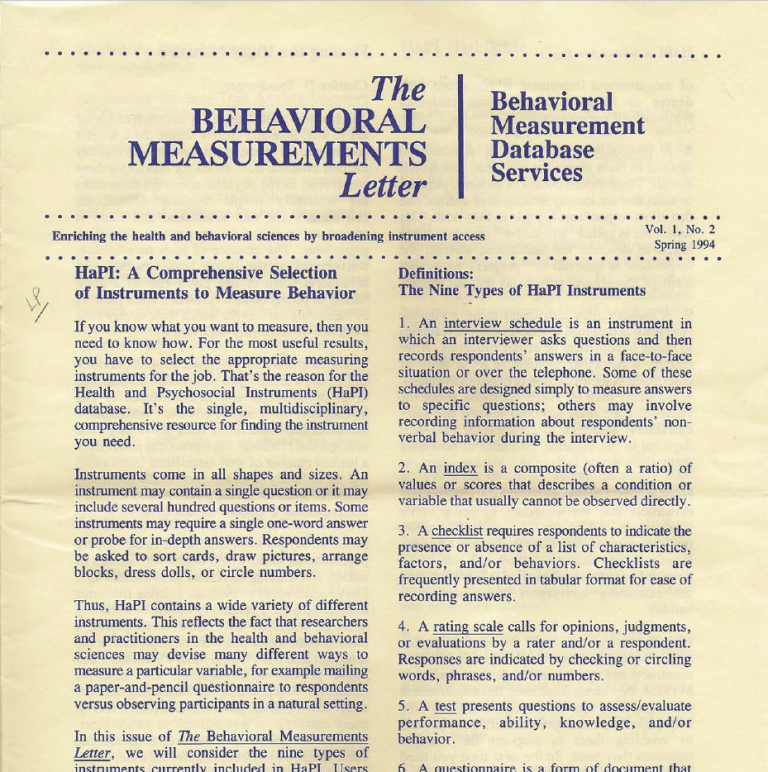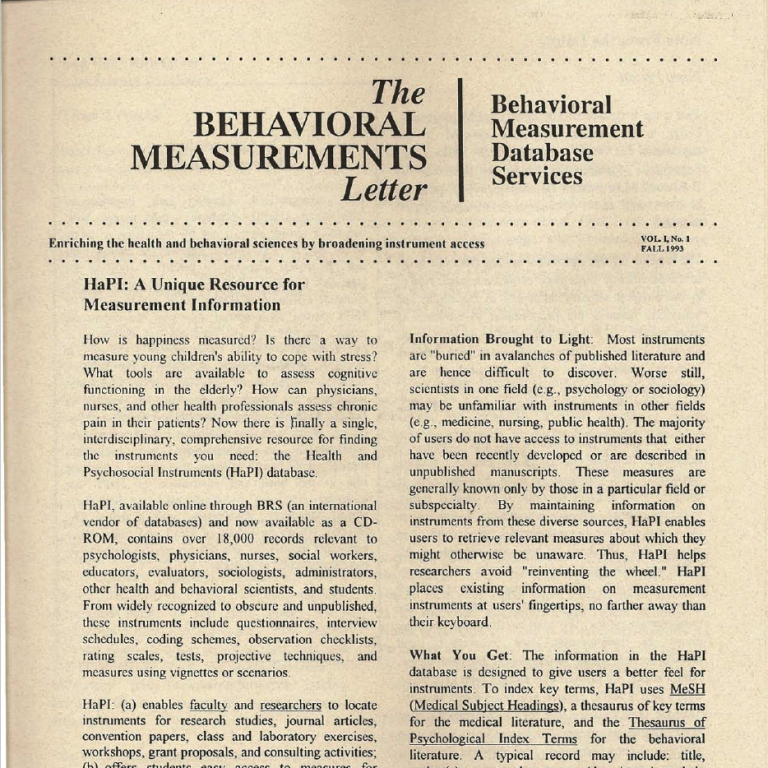Vol. 1, No. 2: Spring 1994
If you know what you want to measure, then you need to know how. For the most useful results, you have to select the appropriate measuring instruments for the job. That’s the reason for the Health and Psychosocial Instruments (HaPI) database. It’s the single, multidisciplinary, comprehensive resource for finding the instrument you need.
Instruments come in all shapes and sizes. An instrument may contain a single question or it may include several hundred questions or items. Some instruments may require a single one-word answer or probe for in-depth answers. Respondents may be asked to sort cards, draw pictures, arrange blocks, dress dolls, or circle numbers.
Thus, the HaPI database contains a wide variety of different instruments. This reflects the fact that researchers and practitioners in the health and behavioral sciences may devise many different ways to measure a particular variable, for example mailing a paper-and-pencil questionnaire to respondents versus observing participants in a natural setting.
In this issue of The Behavioral Measurements Letter, we will consider the nine types of instruments currently included in HaPI. Users who consult HaPI may have many questions about the different kinds of instruments available to measure specific constructs and variables.
The Nine Types of HaPI Instruments
Definitions
- An interview schedule is an instrument in which an interviewer asks questions and then records respondents’ answers in a face-to-face situation or over the telephone. Some of these schedules are designed simply to measure answers to specific questions; others may involve recording information about respondents’ nonverbal behavior during the interview.
- An index is a composite (often a ratio) of values or scores that describes a condition or variable that usually cannot be observed directly.
- A checklist requires respondents to indicate the presence or absence of a list of characteristics, factors, and/or behaviors. Checklists are frequently presented in tabular format for ease of recording answers.
- A rating scale calls for opinions, judgments, or evaluations by a rater and/or a respondent. Responses are indicated by checking or circling words, phrases, and/or numbers.
- A test presents questions to assess/evaluate performance, ability, knowledge, and/or behavior.
- A questionnaire is a form of document that asks respondents to answer the questions presented. Questionnaires may be completed individually and/or in a group setting.
- A coding scheme, e.g., content analysis, translates qualitative information into categorical and then numerical (quantitative) scores. This type of measurement instrument is concerned with degree or intensity of responses, including frequency of occurrence.
- A projective technique is a standardized method to elicit responses to vague, ambiguous stimuli. These stimuli consist of pictures, phrases, or tasks that are loosely structured or defined and that allow respondents to reply as they wish. This technique is called “projective” because, when asked to describe the ambiguous stimuli, the respondent is believed to “project” his or her feelings, thoughts, or personality onto the stimuli.
- A measurement instrument using a vignette (scenario) is designed to assess people’s reactions to either hypothetical or actual situations. After reading a particular vignette (e.g., a story or description of an interaction between individuals), respondents may be asked questions about the vignette, e.g., their attitudes toward the story characters, solutions to conflicts or problems depicted in the vignette, estimates of how they themselves would behave in a similar situation.
HaPI provides access to instruments to measure constructs that are identified as being either synonymous or different. This capability enables implementation of Campbell and Fiske’s (Psychological Bulletin, 1959, 56, 81-105), powerful multitrait-multimethod (MTMM) matrix for examining convergent and discriminant validity.
Unfortunately, although researchers often acknowledge the importance of using multiple constructs and multiple methods as embodied in MTMM, they rarely implement this measurement technique fully and effectively. HaPI can now help researchers and practitioners do this work by enabling them to pinpoint the multiple measures they need. So the next time you need instruments, don’t worry, just search HaPI.
Linda Perloff
Editor
“There is no such source of error as the pursuit of absolute truth.”
Samuel Butler
Finding the Right Measure
Charles D. Spielberger
The essential first steps in any research endeavor are to articulate and clearly define the scientific concepts to be investigated, and then to identify the best available instruments for measuring these constructs. In the physical sciences, these tasks are relatively simple because definitional conventions are well-established and there is consensus in regard to appropriate measuring procedures. The absence of such paradigmatic conventions in the health, psychosocial, and behavioral sciences has given rise to a great variety of poorly defined constructs and a plethora of measuring devices for which there is very little evidence of reliability and validity.
In assessing complex psychosocial and behavioral constructs, a serious flaw that is often encountered in biopsychosocial and health studies is that investigators often employ crude or “homemade” measures that have never been previously used in empirical research. Such practices result from a limited number of well-established instruments and the difficulty of locating potentially promising measures scattered across a voluminous literature encompassing a number of disciplines.
Based on my personal experience in developing psychometric tests, which began with studies of anxiety and learning more than three decades ago, I have endeavored to evaluate existing measures to determine their suitability for use as a starting point in research. Like most investigators, I initially used scales that were most popular at the time, but also tried to find other instruments that might provide more accurate and sensitive measures. Since scales for measuring anxiety were developed in different disciplines and in many countries, it was difficult to locate them. With the accumulation of research evidence, the construct of anxiety has evolved over time, which required modification and refinement of existing measures of this construct. The emergence of the state-trait distinction in anxiety research, first conceptualized by Cattell and implicitly recognized by Zuckerman in the Today and General forms of the Affect Adjective Checklist (AACL), provided the major impetus for constructing the State-Trait Anxiety Inventory (STAI). If HaPI had been available in the late 1950’s, this work could have proceeded much more rapidly.
Over the past 20 years, a large number of instruments for measuring health, psychosocial, and behavioral constructs has been developed in America.
Therefore, scientists from other countries will find the HaPI database especially useful in identifying instruments that may be adaptable for their own research and practice. In working with colleagues from abroad on adapting my anxiety and anger measures, I have been increasingly impressed with instruments developed in other countries. Earlier knowledge of these instruments would have enhanced and speeded the test construction and adaptation process of my own measures. With enhanced coverage of the international research literature, HaPI will be invaluable for crosscultural research.
Charles D. Spielberger, PhD, is Distinguished Research Professor and Director, Center for Research in Behavioral Medicine and Health Psychology at the University of South Florida, where he has been a faculty member since 1972. He is an ABPP Diplomate in Clinical Psychology, a Distinguished Practitioner of Psychology of the National Academies of Practice, and a past president of the American Psychological Association. His State-Trait Anxiety Inventory, with adaptations in 48 languages and dialects, has become the standard international measure of anxiety. He is also author of the Test Anxiety Inventory, the State-Trait Anger Expression Inventory, and the Job Stress Survey.
HaPI Highlights
Anne Butz Canny
The Health and Psychosocial Instruments (HaPI) database, providing extensive, readily available information on measurement instruments in the health and behavioral sciences is produced by Behavioral Measurement Database Services in Pittsburgh, Pennsylvania.
HaPI was created by Dr. Evelyn Perloff at the University of Pittsburgh School of Nursing. The database began as a local resource of information relevant primarily to nursing, but pertinent to other health and psychosocial sciences. Information was assembled in file folders and was retrieved manually.
The collection continued to grow, and in 1985, the National Institute for Nursing Research (as it is now called) funded the development of a computerized, online database that would be available nationally to faculty, researchers, clinicians, and students.
By 1988, the database had approximately 2000 instruments and became available online through BRS Search Services (a vendor of databases). A year later Behavioral Measurement Database Services (BMDS) was established to produce, maintain, and continue development of the database, and HaPI was expanded to include increased coverage in specific fields of the health and behavioral sciences.
For easiest, widest accessibility, HaPI became available in CD-ROM format beginning in 1992.
Both the online file and the CD-ROM virtually contain over 21,000 records: the online version is updated quarterly and the CD-ROM is updated semi-annually.
The newest highlight is this newsletter, The Behavioral Measurements Letter, devoted to the exploration of timely topics relevant to measurement in the health and behavioral sciences.
For Good Measure
Robert Perloff
Measuring something, anything – animal, mineral, or vegetable – has obsessed and been of inestimable value to humankind since living creatures inhabited our planet. How many logs were needed to burn in order to keep the prehistoric family warm? How many dollars is an ounce of gold worth? How much less horsepower will it take to see the USA in your Chevrolet than in your father’s Oldsmobile? And the day after the closing of the XXV Olympiad in Barcelona, the New York Times began an olympic story thus: “Olympic success is not an easy thing to measure, woven as it is through a loom of human drama and national pride.” A world without measurement is as unthinkable as baseball without hot dogs, Gilbert without Sullivan, or computers without software.
In this column are illustrations of the huge reliance we place on measurement for helping us describe our feelings, make decisions, and assert similarities and differences among people and among the objects we deal with in our everyday lives.
To measure is to determine a person’s or an object’s dimensions, quantity, or capacity. An index of the complexity and breadth of the concept of measurement is its length of coverage in the premier dictionary, the Oxford English Dictionary. Variations of measure in the OED occupy 4 pages of the encyclopedia-sized volume, or around 13 columns of small print material defining and describing a dozen or so forms of measuring, varying from measurability, measurage (a duty payable on the cargo of a ship), down through measureless, measurement, and measuringly. (“A hard, sad-looking woman looked at me measuringly!”). These 13 columns consume 130 inches (the height of 1½ basketball superstars) of measurement desiderata, which is all the more impressive considering that in the OED, 4 columns are given to health, 5 to the Bible, 9 to money, and 10 to intelligence and its variations.
Now to see how pervasive and inescapable measurement is in many spheres of our daily existence. These spheres, it should be added, are merely samples of how we depend on measuring, and not the “whole ball of wax” (speaking measuringly).
A Potpourri of Phrases. A baker’s dozen. At a snail’s pace. Capital-gains tax. Cash cow. Cash in on. He fancied fast women and fast cars. Double or nothing. Dow Jones Industrial Average. e pluribus unum (one out of many). Eastern Standard Time. GNP (gross national product). Half-baked. Half-hearted. Half-wit. Jerry Brown’s 800 number. Menage a trois. No, no, a thousand times no. Pay through the nose. Payola. Split the difference. Take the Fifth (amendment). The long and short of it. The whole nine yards. 30 days hath September, April, June and November; all the rest have 31, except February, which stands alone. The three Rs. Turn a cold shoulder to. Two-bits. Two’s company, three’s a crowd.
Entertainment and Literature. ” A thousand clowns.” “Born on the Fourth of July.” “Come back little Sheba.” “How do I love thee – let me count the ways.” “Long day’s journey into night.” Shakespeare’s “Measure for Measure.” “The Children’s Hour.” “The Price is Right.” ”Twelve O’Clock High.” ”What Price Glory?”
Records. Babe Ruth struck out 1,330 times (but hit 714 home runs). John Creasy got 753 rejection slips before he published 564 books. HaPI virtually has 21,000 records on line. The best record in the Kentucky Derby was 1:59.2 by Secretariat (in 1973). The light of the sun reaches the earth in 499.012 seconds, or slightly more than 8 minutes. The longest suspension bridge (its lengthiest span being 4,260 feet) in North America is the Verrazano-Narrows in New York. The United States won 108 medals in the XXV Olympiad in Barcelona in 1992. The world’s longest railway tunnel is Seiken, in Japan, 33.5 miles.
Songs. ” A bushel and a peck.” ” All or nothing at all.” ”Beat me daddy eight to the bar.” ”By the time I got to Phoenix.” ” Count every star.” “Cuddle a little closer, lovely mine.” “Enjoy yourself (it’s later than you think).” “Five foot two, eyes of blue.” “How high the moon?” “How much is that doggie in the window?” “I found a million dollar baby (in the 5 and 10 cent store.” “I got it bad and that ain’t good.” “I’m looking over a four-leaf clover.” “More.” “On a slow boat to China.” ”One for my baby (and one for the road).” “Seventy-six trombones.” ” Supercalifragilisticexpialidocious” (the song with the largest number of letters – from Mary Poppins). “Three coins in the fountain.” “12th Street rag.”
This column has 749 words, I hope it measured up.
Robert Perloff, PhD, is Distinguished Service Professor of Business Administration and of Psychology at the University of Pittsburgh. He has been president of many national professional and scientific societies including the American Psychological Association, the American Evaluation Society and the Society of Psychologists in Management. Dr. Perloff has not only contributed to behavioral measurement development and validation, but he has also relied upon and benefited from measurement in his research, teaching, and consultation in the fields of organizational behavior, consumer studies, program evaluation, mental health, and knowledge utilization.
Question: Why Another Newsletter?
Answer:
Why another newsletter? Why The Behavioral Measurements Letter? Because this is not just another newsletter. This is The Behavioral Measurements Letter. Accurate measurement in the health and behavioral sciences needs approaches that are specific to a single discipline and are at the same time congenial multidisciplinarily. The Behavioral Measurements Letter is a forum — your forum — for measurement professionals and measurement users to communicate in order to exchange ideas; ask questions and get answers about measurement issues; discuss specific constructs, old and new; collaborate on instrument construction, validation, and data collection; and, best of all, to dialogue informally with colleagues who have similar interests in sharing their excitement about and commitment to health and behavioral measurement. Help us make this an exciting and successful endeavor. Call, fax, or write us; we are anxious to hear from you so that The Behavioral Measurements Letter will sustain and stretch your belief in health and behavioral measurement.
Read additional articles from this newsletter:
Service Quality: Its Importance to Librarians
1-2-spring-1994
